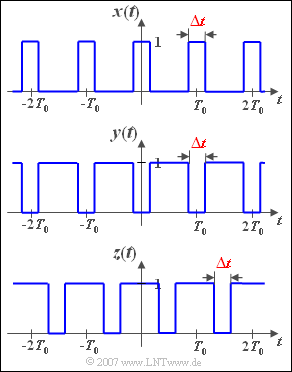Difference between revisions of "Aufgaben:Exercise 2.5Z: Square Wave"
m (Oezdemir moved page Aufgabe 2.5Z: Rechtecksignale to Exercise 2.5Z: Square Wave) |
|||
| Line 4: | Line 4: | ||
[[File:P_ID323__Sig_Z_2_5.png|right|frame|Verschiedene Rechtecksignale]] | [[File:P_ID323__Sig_Z_2_5.png|right|frame|Verschiedene Rechtecksignale]] | ||
| − | + | The signal $x(t)$ periodic with time $T_0$ is described by the single parameter $\Delta t$ ; let the amplitude of the square-wave pulses be $1$ in each case. Since $x(t)$ is even, all sine coefficients $B_n = 0$. | |
| − | + | The DC signal coefficient is $A_0 = \Delta t/T_0$ and the following applies to the cosine coefficients: | |
:$$A_n=\frac{2}{n\pi}\cdot \sin(n\pi \Delta t/T_0).$$ | :$$A_n=\frac{2}{n\pi}\cdot \sin(n\pi \Delta t/T_0).$$ | ||
| − | In | + | In subtasks '''(1)''' and '''(2)''' the signal $x(t)$ is analysed for the two parameter values $\Delta t/T_0 = 0.5$ and $\Delta t/T_0 = 0.25$ respectively. |
| − | + | Then we consider the two signals $y(t)$ and $z(t)$, each with $\Delta t/T_0 = 0.25$. There is a fixed relationship between these signals and $x(t)$ which can be exploited for the calculation. | |
| Line 18: | Line 18: | ||
| − | '' | + | ''Hints:'' |
| − | * | + | *This exercise belongs to the chapter [[Signal_Representation/Fourier_Series|Fourier Series]]. |
| − | * | + | *You can find a compact summary of the topic in the two learning videos |
::[[Zur_Berechnung_der_Fourierkoeffizienten_(Lernvideo)|Zur Berechnung der Fourierkoeffizienten]], | ::[[Zur_Berechnung_der_Fourierkoeffizienten_(Lernvideo)|Zur Berechnung der Fourierkoeffizienten]], | ||
:: [[Eigenschaften_der_Fourierreihendarstellung_(Lernvideo)|Eigenschaften der Fourierreihendarstellung]]. | :: [[Eigenschaften_der_Fourierreihendarstellung_(Lernvideo)|Eigenschaften der Fourierreihendarstellung]]. | ||
| Line 28: | Line 28: | ||
| − | === | + | ===Questions=== |
<quiz display=simple> | <quiz display=simple> | ||
| − | { | + | {Whcih statements are true for the signal $x(t)$ with $\Delta t/T_0 = 0.5$? |
|type="[]"} | |type="[]"} | ||
| − | + | + | + The spectral function ${X(f)}$ contains a Dirac function at $f = 0$ with the weight $0.5$. |
| − | - | + | - The spectral function ${X(f)}$ contains Dirac lines at all multiples of the base frequency $f_0 = 1/T_0$. |
| − | + | + | + The spectral function ${X(f)}$ contains diraclines at odd multiples of the base frequency $f_0$. |
| − | - | + | - The spectral line at $f_0$ has the weight $2/\pi = 0.636$. |
| − | + | + | + The spectral line at $–\hspace{-0.1cm}f_0$ has the weight $1/\pi = 0.318$. |
| − | { | + | {Which statements are true for the signal $x(t)$ with $\Delta t/T_0 = 0.25$? |
|type="[]"} | |type="[]"} | ||
| − | + | + | + The spectral function ${X(f)}$ contains diraclines at all odd multiples of the base frequency $f_0$. |
| − | + ${X(f)}$ | + | + ${X(f)}$ has diraclines at $\pm2f_0$, $\pm6f_0$, $\pm10f_0$, etc. |
| − | - ${X(f)}$ | + | - ${X(f)}$ has diraclines at $\pm4f_0$, $\pm8f_0$, $\pm12f_0$, etc. |
| − | + | + | + The spectral line at $2f_0$ has the weight $1/(2\pi) = 0.159$. |
| − | { | + | {What is the DC component of the signal ${y(t)}$? |
|type="{}"} | |type="{}"} | ||
$y(t)$: $A_0 \ = \ $ { 0.75 3% } | $y(t)$: $A_0 \ = \ $ { 0.75 3% } | ||
Revision as of 21:12, 16 January 2021
The signal $x(t)$ periodic with time $T_0$ is described by the single parameter $\Delta t$ ; let the amplitude of the square-wave pulses be $1$ in each case. Since $x(t)$ is even, all sine coefficients $B_n = 0$.
The DC signal coefficient is $A_0 = \Delta t/T_0$ and the following applies to the cosine coefficients:
- $$A_n=\frac{2}{n\pi}\cdot \sin(n\pi \Delta t/T_0).$$
In subtasks (1) and (2) the signal $x(t)$ is analysed for the two parameter values $\Delta t/T_0 = 0.5$ and $\Delta t/T_0 = 0.25$ respectively.
Then we consider the two signals $y(t)$ and $z(t)$, each with $\Delta t/T_0 = 0.25$. There is a fixed relationship between these signals and $x(t)$ which can be exploited for the calculation.
Hints:
- This exercise belongs to the chapter Fourier Series.
- You can find a compact summary of the topic in the two learning videos
Questions
Musterlösung
- Die Spektralfunktion beinhaltet eine Diracfunktion bei $f = 0$ mit dem Gewicht $0.5$ (Gleichanteil) sowie weitere Spektrallinien bei ungeradzahligen Vielfachen ($n = \pm1, \pm3, \pm5,\text{...}$) von $f_0$.
- Die Gewichte bei $\pm f_0$ sind jeweils $A_1/2 = 1/\pi = 0.318$.
(2) Richtig sind die Aussagen 1, 2 und 4:
- Bei allen ungeradzahligen Vielfachen der Grundfrequenz existieren Spektrallinien, zusätzlich noch bei den $2–{\rm fachen}$, $6–{\rm fachen}$ und $10–{\rm fachen}$.
- Beispielsweise gilt $A_1 = 1/\pi = 0.450$. Die Spektrallinie bei $2f_0$ hat somit das Gewicht $A_2/2 = 1/(2\pi) = 0.159$.
- Für $n = 4$, $n = 8$, usw. sind dagegen die Koeffizienten $A_n = 0$, da für die Sinusfunktion gilt: $\sin(\pi) = \sin(2\pi) =\text{ ...} = 0$.
(3) Aus der grafischen Darstellung des Signals ${y(t)}$ wird deutlich, dass $A_0 = 0.75$ gelten muss. Zum gleichen Ergebnis kommt man über die Beziehung:
- $$A_0^{(y)}=1-A_0^{(x)}=1-0.25\hspace{0.15cm}\underline{=0.75}.$$
(4) Es gilt ${y(t)} = 1 - x(t)$. Für $n \neq 0$ ergeben sich somit die gleichen Fourierkoeffizienten wie für das Signal $x(t)$, jedoch mit negativen Vorzeichen. Inbesondere gilt:
- $$A_1^{(y)} = -A_1^{(x)}=-{2}/{\pi} \cdot \sin({\pi}/{4})= -{\sqrt2}/{\pi}\hspace{0.15cm}\underline{\approx -0.450},$$
- $$A_2^{(y)} = -A_2^{(x)}=-{1}/{\pi}\hspace{0.15cm}\underline{ \approx - 0.318}.$$
(5) Es gilt ${z(t)} = y(t - T_0/2)$. Mit der Fourierreihendarstellung von ${y(t)}$ folgt daraus:
- $$z(t)=A_0+A_1^{(y)}\cos(\omega_0(t-\frac{T_0}{2}))+A_2^{(y)}\cos(2\omega_0(t-\frac{T_0}{2}))+A_3^{(y)}\cos(3\omega_0(t-\frac{T_0}{2}))+\ldots$$
- $$\Rightarrow \quad z(t)=A_0-A_1^{(y)}\cos(\omega_0 t)+A_2^{(y)}\cos(2\omega_0 t)-A_3^{(y)}\cos(3\omega_0 t)+\text{...}$$
Damit erhält man:
- $$A_1^{(z)}=-A_1^{(y)}={\sqrt2}/{\pi}\hspace{0.15cm}\underline{=+0.450}, \hspace {0.5cm} A_2^{(z)}=A_2^{(y)}=-{1}/{\pi}\hspace{0.15cm}\underline{=-0.318}.$$
Das gleiche Ergebnis erhält man ausgehend von den gegebenen Koeffizienten mit $\Delta t/T_0 = 0.75$:
- $$A_1^{(z)}={2}/{\pi} \cdot \sin({3}/{4}\cdot \pi)={\sqrt2}/{\pi}, \hspace {0.5cm}A_2^{(z)}= {1}/{\pi} \cdot \sin({3}/{2} \cdot \pi) =-{1}/{\pi}.$$
